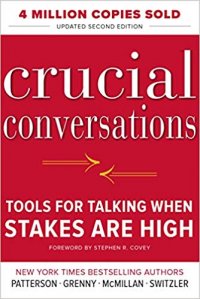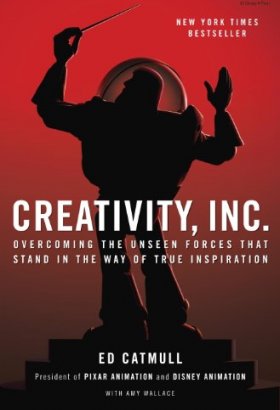You may also like

Crucial Conversations
by Patterson, Grenny, McMillan, and Switzler
The Five Dysfunctions of a Team
by Patrick Lencioni






by Ed Catmull & Amy Wallace
In 1995, Pixar successfully released Toy Story, the first full length feature film created solely with computer animation. Ed Catmull, co-founder of Pixar, had accomplished his life-long mission of doing just that and now felt lost. What do you do next when you’ve accomplished something you’ve been working towards for more than 20 years? He realized that he and the team had developed something new and innovative, so he shifted his focus to how other ‘Titans of New’ often failed to survive after early success. His new mission was not only to build a successful company, but one with a sustained culture of creativity. Creativity, Inc. is the story of how he did it.
Part I focuses on the early stages of Catmull’s professional life, through starting as a graduate student at the University of Utah, to being hired by LucasFilms to head their computer division, to eventually being sold to Steve Jobs. At the U of U Catmull was introduced to; 1) a number of people that would play a role in Pixar’s success (both directly and via future corporate partnerships) and 2) an organization that empowered smart people to innovate for innovation’s sake – something which Catmull would find difficult to balance in a for-profit organization. One key takeaway he had from his time in post-graduate academia was the faculty needed to know when to provide feedback and when to stand back so as to not stifle the students’ creativity. This was a cultural attribute he would try to reproduce at Pixar.
After Toy Story and A Bug’s Life had been released, Catmull started asking bigger questions:
It was clear that the next goal for Catmull would be to “figure out how to build a sustainable creative culture.” It wouldn’t be a “singular assignment. It was a day-in-day-out, full-time job.” Chapter 4: Establishing Pixar’s Identity starts this off by describing the successes and failures uncovered during the production of Toy Story 2, when Pixar needed to replace the director of the film halfway through its development, citing, “it was the first time we gave a position to someone believing they could do it, only to find that they couldn’t.” The new leaders decided to completely revamp the film with only 1 year until it was due to hit theaters, during which Catmull and his fellow Pixar leaders discovered the following:
Candor and Feedback
Catmull attributes much of Pixar’s success to how their culture values candor: “A hallmark of a healthy creative culture is that its people feel free to share ideas, opinions, and criticisms.” Protecting the ability for people to feel comfortable when speaking up is a job that never ends for those in leadership positions: “Lack of candor, if unchecked, ultimately leads to dysfunctional environments.”
Being wrong is not the problem; the problem is not knowing you’re wrong or not knowing how to correct it. A culture of candor solves both of those problems. However, candor is only valuable if the receiver is willing to take that feedback and be open rather than defensive; Pixar created a forum for candor and feedback called The Braintrust. The key in these sessions is to look at feedback as additive rather than competitive, with each participant contributing something to the conversation. There are dozens of stories in Creativity, Inc. of how The Braintrust helped a team through a problem. While they do not always provide an answer, they will at least identify if something is wrong or incomplete: “Any successful feedback system is built on empathy, with the idea that we are all in this together.” Catmull urges us to create our own solution group, like Pixar’s Braintrust. The individuals should, combined, make you smarter and offer quick feedback. It’s not about providing THE ANSWER; its about brainstorming and helping us get past our own roadblocks.
Fear, Failure, and Teaching
Whenever you’re doing something new, mistakes are inevitable. If we’re fortunate, we find, correct, and use our mistakes as learning experiences before the public knows about them. Fear can often drive us to overprepare in an attempt to prevent mistakes, but Catmull warns us:
When exploration and experimentation are viewed as productive necessities rather than a waste of time, people will enjoy their work: “Experimentation is scary to many… we should be far more terrified of the opposite approach.” We must uncouple fear from failure: “The antidote to fear is trust.” If we are patient, authentic, and consistent, trust will come and our teams will be more comfortable with failing an experiment and learning from it.
“As leaders, we should think of ourselves as teachers and try to create companies in which teaching is seen as a valued way to contribute to the success of the whole.” We cannot assume that the next person will become successful just because others have figured it out. We tell ourselves that we will spend more time investing in our teams, but that time is often eaten by the demands of the day-to-day. We MUST make time for teaching so that our team is enabled and empowered to fix their problems: “Management’s job is not to prevent risk but to build the ability to recover.”
The Hungry Beast and the Ugly Baby
Catmull describes what success can do to a company; success drives the demand for MORE SUCCESS. It adds the pressure to create and to do it quickly, but if left unchecked it will lessen the quality. That is the nature of the ‘Beast’ and its never-ending hunger: “The Beast’s hunger translates into deadlines and urgency. That’s a good thing, as long as the Best is kept in its place. And that’s the tough part.”
On the opposite side is our creativity: “Originality is fragile.” Ideas in their early stage are ugly, poorly defined, and difficult to explain. Ideas may not even appear to be anything that can eventually evolve into something successful; they are a baby that must be coddled: “For greatness to merge, there must be phases of not-so-greatness.”
This is what must be balanced in a business driven by creativity. If either the Hungry Beast or the Ugly Baby win, the company loses. Catmull admits that he, “could never fully explain how to achieve this balance. That you only learn by doing.” His advice though? “Managers of creative enterprises must hold lightly to goals and firmly to intentions.”
Change, Randomness, and the Hidden
We can’t avoid change, no matter how hard we try - nor should we want to! “There is no growth or success without change.” But, without fail, as we experience success we hang on to those things that brought success, not truly knowing which parts are worth keeping and which are worth discarding.
Randomness is deeply embedded in everything we do and contributes to both our successes and our failures. Worse yet, our brains aren’t wired for us to contemplate it. We are a pattern driven species, so much so that we see patterns that don’t even exist. If we fail to recognize those false patterns of randomness, we fail to identify which strategies of success to hold on to and we won’t learn from our failures.
As your role changes within a company (e.g. promotions, influence, etc.), people will become more guarded around you. You may no longer see gradual changes in behavior; always be cognizant that you don’t see much of your team’s one-on-one interactions. The knowledge that some problems will always be hidden will make you a better manager. Go find them, ask thought-provoking questions, and extract that information from your teams. Don’t be afraid of appearing to not be in control; complex environments are complex and you cannot know everything. Focus on the techniques to combine stories from different sources, find their interrelationships, and hunt down those problems that are outside your view. Only by acknowledging your blind spots can you really accomplish that.
Broadening Our View
Catmull describes four very high-level factors (obstacles?) that impact how we manage:
He then goes on to describe several mechanisms that can help change our frame of mind and overcome those obstacles:
The Unmade Future
Rather than having the confidence to know exactly where you’re going, instead have confidence that we can figure it out together.
Other people are our best allies for overcoming our obstacles, “but that alliance takes sustained effort to build. You should be prepared for that, not irritated by it.”
People often repeat what has worked in the past. It’s important to use our skills, knowledge, and experiences to invent rather than duplicate. Duplication is neither original nor creative.
Leaders need to adapt to their current situation. Sometimes they need to be decisive, sometimes they need to get out of the way: “Sometimes I run the room, and sometimes I say nothing and let the room run itself.”
“The future is unmade, and we must create it.”
The last section in the book covers two monumental events at Pixar. The first is the sale of Pixar to Disney, in which Ed Catmull would become president of Disney Animation and Pixar studios, overseeing both organizations. Pixar was worried about losing their culture, something they have worked so hard to build. Disney Animation had lost their engine which drove creativity, but that didn’t mean that Disney Animation didn’t have anything to teach Pixar; Disney had tremendous marketing and distribution knowledge. It was clear that both teams could learn from and needed each other.
The other pivotal event Catmull describes is ‘Notes Day,’ a day where Pixar executives rallied all employees to help solve Pixar’s foreseen sustainability problem. Costs and human hours were increasing year over year at a faster pace than anticipated outputs (movies) and revenues. The day was an attempt to demolish the roadblocks that were getting in the way of candor. It did not only that, but it was a tremendous motivator for the entire organization, involving people in what interested them. Notes Day worked because; 1) it had a clear and focused goal, 2) it was an idea championed and supported at the highest levels of the company, and 3) it was led from within, where employees took on the enormously time-consuming task of identifying the topics, structuring the conversations, and creating an environment where the entire staff could contribute - even if it was outside of their swim lane.
In the Afterword, Catmull tells the story of a different Steve Jobs to the one we hear about in the media, movies, and even in the Steve Jobs endorsed biography. Jobs played an integral role in the survival of Pixar during its early days, as well as its success throughout its lifetime right up until his death. Jobs was involved from buying the division from LucasFilms, to losing millions of dollars in the early years (when Pixar started as a computer hardware company, pivoting to create original content with the hardware and software they had developed), to the eventual sale of Pixar to Disney. Each pivot and transition that Pixar went through, Jobs was there. He not only helped form and execute key strategies, but he also served as a mentor, guiding Ed and John through those transition periods. The Afterword was a fitting tribute to Steve’s role in the company, telling the story of how Steve evolved over the course of his life (something we often do not hear of Steve), ending Creativity, Inc. on an emotional note that made me tear up. I highly recommend this to anyone who enjoys reading about one of the great innovators of our time.
At Pixar, Catmull’s focus was always to make sure to tell the best story they could - that carries over to Creativity, Inc. It’s an overall easy read with many humorous anecdotal stories, used to describe behaviors, techniques, and thought processes that helped Pixar stay true to their guiding principles. To top it all off, perhaps the most enjoyable part of Creativity, Inc. was learning about the behind-the-scenes activities that go into making some of our favorite movies and hearing of the struggles that Pixar faced while doing so.


